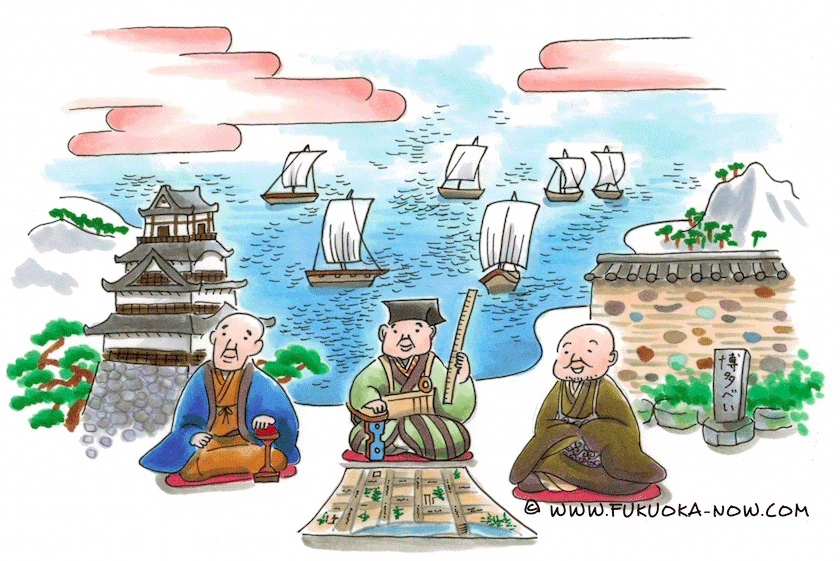Hakata Culture vol.115
Hakata: A City Built by Merchants

A gateway to the outside world since olden times, Hakata began to flourish as a commercial port city in the middle ages. Hakata began trading with Ming China under a system called kango boeki (“tally trade”; a system in which only ships officially registered by the Ming could engage in trade), but not long after, it expanded its reach to the Korean peninsula and Southeast Asia via the Ryukyu Islands (now Okinawa). As Hakata grew into a commercial hub, a handful of influential traders came to the fore, the three most powerful of whom were Sokan Kamiya, Soshitsu Shimai and Soku Oga.
Kamiya was born into a wealthy merchant family. He played a key role in the redistricting of Hakata ordered by Hideyoshi Toyotomi in 1587. It is said that he personally walked around the city with a measuring stick to get the job done. Not long after this, through his dealings with China and prime position in the rice trade, he rose to the top of merchant class in Hakata. The ruins of Kamiya’s residence can be found in present-day Narayamachi (Hakata Ward) along with Toyotomi Shrine, which is dedicated to Hideyoshi. Meanwhile, his final resting place is on the grounds of Myorakuji Temple.
Soshitsu Shimai, a merchant who won the trust of both Hideyoshi and Sorin Otomo (the lord of what is now Oita), made his fortune in sake brewing and finance. He is said to have forged a trading route with Korea that passed through Tsushima Island. The unique earthen walls surrounding the ruins of Shimai’s residence were topped with locally made shingles called Hakata-bei. Fortunately, these walls managed to survive the bombings during World War II, after which they were moved to Kushida Shrine for safekeeping. Shimai’s tomb lies within the premises of Sofukuji Temple.
Unlike Kamiya and Shimai, Oga was not a born-and-bred Hakatan: he came from Nakatsu in Buzen Province (now western Oita Prefecture). He moved to Hakata when Nagamasa Kuroda, the lord of the Nakatsu Domain, relocated to Chikuzen (now Fukuoka). He was pivotal in the construction of Fukuoka Castle and the surrounding town as well as the reconstruction of temples and shrines in Hakata. He also engaged in trade with Southeast Asia. Having won the trust of the Kuroda Clan, the Oga family flourished as merchants until the end of the Edo period. His grave is located at Genjuan, a subtemple of Shofukuji Temple.
自治都市を支えた博多の商人
古代から海外との交流が盛んだった博多は、中世になると商業港として栄えるようになります。勘合符を持つものだけが交易できる中国・明との勘合貿易に始まり、朝鮮との交易、さらには琉球を通じて東南アジアにまで貿易圏を広げていきます。その中で大きな力を持つ商人が生まれ、博多は商人を中心とした自治都市として発展しました。とりわけ有名なのが「博多三傑」と呼ばれる神屋宗湛・島井宗室・大賀宗九の3人です。
神屋宗湛は代々博多の豪商の家に生まれました。豊臣秀吉の「太閤町割」でも重要な役割を果たし、自ら物差しを持って通りを計測して回ったとされます。その後は中国との貿易や米の取引などで博多商人の第一人者として活躍しました。博多区奈良屋町の神屋宗湛の屋敷跡は、現在、豊臣秀吉を祀る豊国神社が建立されています。また墓所は博多区の妙楽寺にあります。
島井宗室は大友宗麟や豊臣秀吉などからの信頼を得て、酒づくりや金融業で財を成しました。朝鮮とも貿易を行い、博多から対馬、朝鮮にいたる交通路を築き上げたとされます。島井宗室の屋敷跡にあった土塀は「博多べい」と呼ばれる瓦を使った独特の造りで、第2次世界大戦中の空襲でも焼け残り、近くの櫛田神社境内に移築・保存されています。墓所は崇福寺にあります。
大賀宗九は博多出身の宗湛・宗室とは違い、もともと豊前国中津の生まれです。中津藩主の黒田長政が筑前国に移るのにあわせて博多に移住しました。福岡城の築城や城下町の整備、博多の寺院の復興などに尽力し、東南アジアとの交易も行いました。黒田藩からの信頼も厚く、大賀家は博多商人として幕末まで続くことになります。墓所は聖福寺の塔頭・幻住庵にあります。

